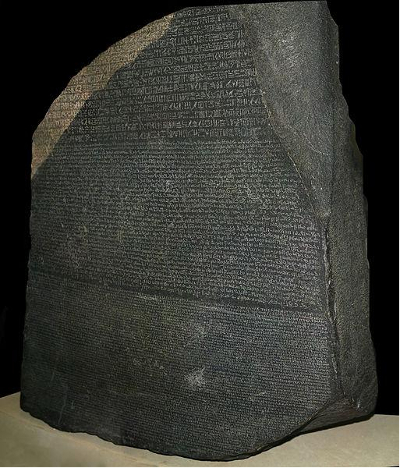The Rosetta Stone is an ancient fragment of granite bearing an inscription written in both Greek and Egyptian. A French engineer discovered the stone near the town of Rosetta (el-Rashid), Egypt in August 1799. It is inscribed in three writing systems, including hieroglyphics, demotic script, and the Greek alphabet. While hieroglyphics had long remained a mystery, the parallel inscriptions on the Rosetta Stone provided the key to finally decoding them.
The stone is a commemorative stela that originally adorned a temple. The inscriptions appear to have been written by the priests of Memphis, a capital of ancient Egypt. The writings extol the achievements of Ptolemy V Epiphanes, a king who ruled the country from 205–180 BCE. It also lists decrees passed in his honor, and describes how the godlike ruler should be praised.
 Englishman Thomas Young and Frenchman Jean-François Champollion both contributed to the decipherment of the stone’s hieroglyphics. Young recognized that the cartouches, or markings enclosed by oval shapes, represented the names of royalty, and that those on the Rosetta Stone referred to Ptolemy. He also determined the direction in which the hieroglyphics should be read. Champollion continued Young’s work, and discovered that while some markings represented individual letters, others stood for syllables, or even previously-expressed ideas. He eventually published an Egyptian dictionary that depicted ancient hieroglyphics and their Greek translations. The men’s painstaking work unlocked the secrets of ancient Egyptian society, and laid the foundation for all future Egyptology studies.
Englishman Thomas Young and Frenchman Jean-François Champollion both contributed to the decipherment of the stone’s hieroglyphics. Young recognized that the cartouches, or markings enclosed by oval shapes, represented the names of royalty, and that those on the Rosetta Stone referred to Ptolemy. He also determined the direction in which the hieroglyphics should be read. Champollion continued Young’s work, and discovered that while some markings represented individual letters, others stood for syllables, or even previously-expressed ideas. He eventually published an Egyptian dictionary that depicted ancient hieroglyphics and their Greek translations. The men’s painstaking work unlocked the secrets of ancient Egyptian society, and laid the foundation for all future Egyptology studies.
The stone is more than three and a half feet tall and two feet thick; it weighs three-quarters of a ton. Pierre François Xavier Bouchard discovered the artifact during a demolition project intended to make way for a French fort. Scholars believe that the stone originated elsewhere, and was later moved to the site of its discovery. The remaining pieces of the stela have never been found. The French transferred ownership of the Rosetta Stone when they surrendered Egypt to the British in 1801. It was sent to the British Museum in London in 1802, and is still on display there today.
Photo credit: © Hans Hillewaert, via Wikimedia Commons.